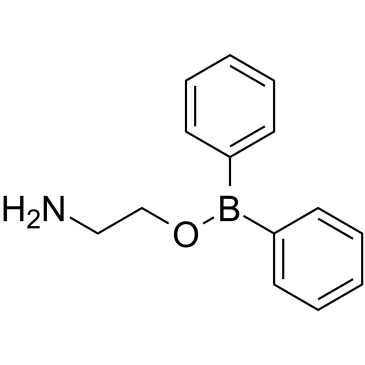
2-APB
CAS No. 524-95-8
2-APB( —— )
Catalog No. M18729 CAS No. 524-95-8
2-Aminoethoxydiphenyl borate (2-APB) is a chemical that acts to inhibit both IP3 receptors and TRP channels (although it activates TRPV1, TRPV2, & TRPV3 at higher concentrations).
Purity : >98% (HPLC)
 COA
COA
 Datasheet
Datasheet
 HNMR
HNMR
 HPLC
HPLC
 MSDS
MSDS
 Handing Instructions
Handing Instructions
| Size | Price / USD | Stock | Quantity |
| 5MG | 34 | In Stock |


|
| 10MG | 47 | In Stock |


|
| 25MG | 74 | In Stock |


|
| 50MG | 111 | In Stock |


|
| 100MG | 177 | In Stock |


|
| 500MG | 440 | In Stock |


|
| 1G | Get Quote | In Stock |


|
Biological Information
-
Product Name2-APB
-
NoteResearch use only, not for human use.
-
Brief Description2-Aminoethoxydiphenyl borate (2-APB) is a chemical that acts to inhibit both IP3 receptors and TRP channels (although it activates TRPV1, TRPV2, & TRPV3 at higher concentrations).
-
Description2-Aminoethoxydiphenyl borate (2-APB) is a chemical that acts to inhibit both IP3 receptors and TRP channels (although it activates TRPV1, TRPV2, & TRPV3 at higher concentrations).
-
In Vitro——
-
In Vivo——
-
Synonyms——
-
PathwayOthers
-
TargetOther Targets
-
RecptorTRPV1|TRPV2|TRPV3|TRPC6|TRPM8|IP3 receptor
-
Research Area——
-
Indication——
Chemical Information
-
CAS Number524-95-8
-
Formula Weight225.09
-
Molecular FormulaC14H16BNO
-
Purity>98% (HPLC)
-
SolubilityIn Vitro:?DMSO : 250 mg/mL (1110.67 mM)
-
SMILESNCCOB(c1ccccc1)c1ccccc1
-
Chemical Name——
Shipping & Storage Information
-
Storage(-20℃)
-
ShippingWith Ice Pack
-
Stability≥ 2 years
Reference
1.Bai et al (2006) Block of specific gap junction channel subtypes by 2-aminoethoxydiphenyl borate (2-APB). J.Pharmacol.Exp.Ther. 319 1452
molnova catalog



related products
-
Brain Injury Derived...
Brain Injury Derived Neurotrophic Peptide
-
Calpain Inhibitor Pe...
Calpastatin subdomain B is a biological active peptide. (inhibit calpain activity)
-
Haloperidol decanoat...
Haloperidol decanoate is a typical antipsychotic agent utilized as maintenance treatment for schizophrenia and mood disorders formulated as an ester for intramuscular injection.



 Cart
Cart
 sales@molnova.com
sales@molnova.com


